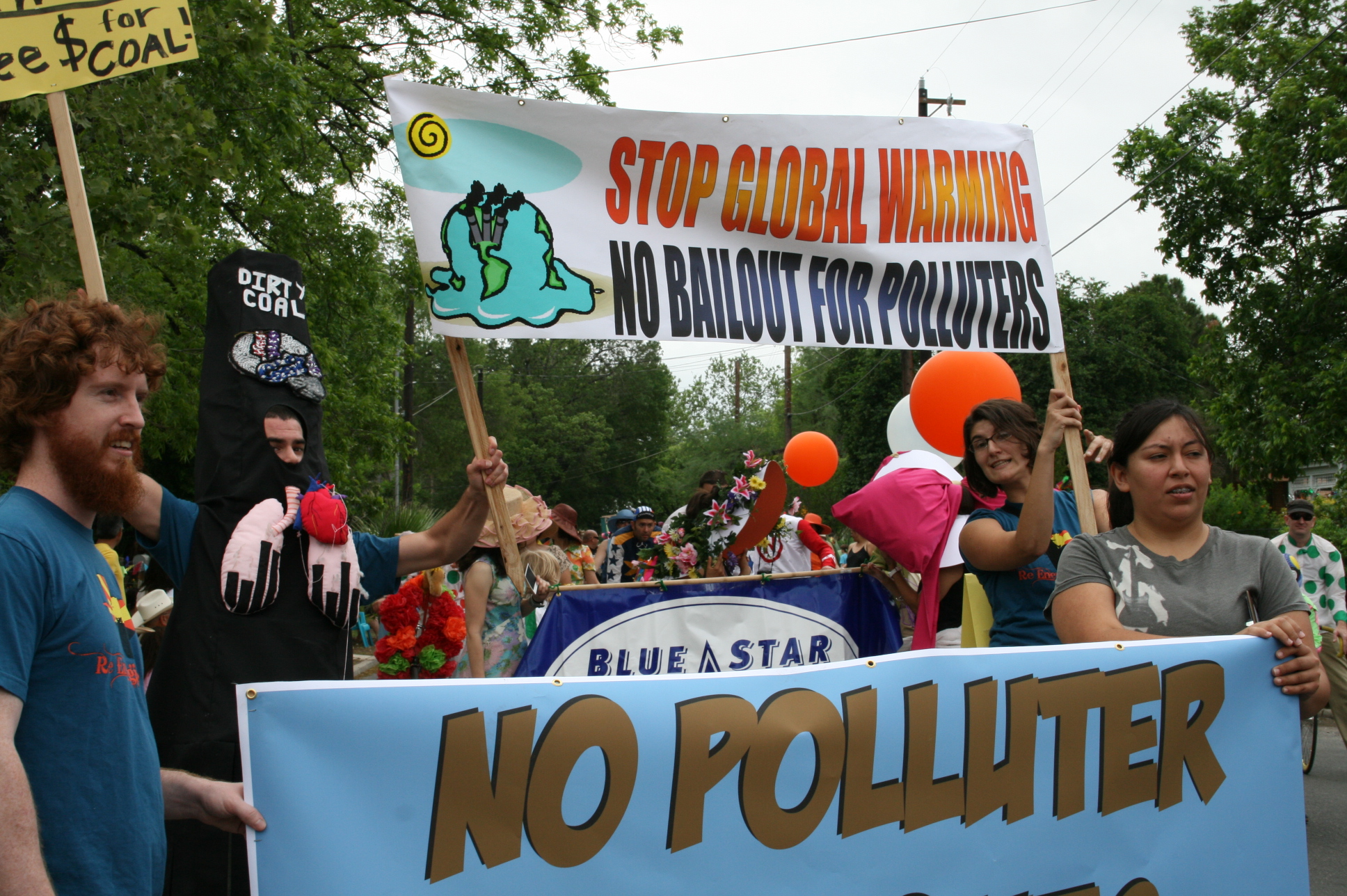
photo courtesy of Karen Hadden & SEED Coalition
Our ambush of U.S. Congressman Charlie Gonzalez at the King William’s Fair in San Antonio this weekend was both a blast and a great success.
If you couldn’t make it out, never fear — Greg Harman at the San Antonio Current did, and just posted a great blog post with full coverage from the parade. Be sure to check out the video, featuring our very own Sarah McDonald, ReEnergize Texas’ Patrick Meaney, and cameos from a whole host of Public Citizen, ReEnergize Texas, and SEED Coalition staff and volunteers.
More good news from the Curblog is that Charlie Gonzalez is still listening to both sides of the auction-or-free-allowances debate, Bloomberg article to the contrary.
Harman reports,
Ginette Magaña, a spokesperson for Rep. Gonzalez, said her boss had not committed to either side on the matter of carbon credits.
Not only that, but no letter exists as reported in the Bloomberg article, she insisted.
“There is no letter,” Magaña said. “He’s still looking at the bill and trying to find the best decision. I don’t have anything other than that right now … Charlie had never signed on to that letter … There is no letter.”
Things are certainly looking up. Check out this diary from Trevor Lovell of ReEnergize Texas fame for another perspective on the parade:
Sorry Charlie, Giveaways Aren’t Green
“This feels like one of the good old campaigns,” said Tom “Smitty” Smith, Executive Director of Public Citizen’s Texas office, Saturday afternoon in reference to activists swarming Congressman Charlie Gonzalez’s carriage in the King William Parade that morning in San Antonio.
Smitty may have been showing his age a bit (he’s directed Public Citizen’s Texas office for the last 25 years, and become a local legend and then some in the process), but the sentiments were positive among organizers young and old alike.
Congressman Charlie Gonzalez is the key swing vote on a subcommittee considering the Waxman-Markey bill. A conservative Democrat, Gonzalez has joined a misguided throng calling for CO2 credits to be given away, a solution deemed unacceptable by environmentalists and economists who point out that such a system would create unfair profits for polluters and cripple any attempt at CO2 real reductions.
Learning late Thursday that Congressman Gonzalez would be in the King William Parade, a Fiesta celebration for the well-to-do and well-connected King William neighborhood of San Antonio, activists at Public Citizen, SEED Coalition, and my group, the ReEnergize Texas student coalition, got together and planned a full scale outreach and publicity action to let the Congressman know that giveaways are unacceptable. (more…)
 This week citizens submitted two separate filings to the Nuclear Regulatory Commission (NRC) opposing Luminant (formerly TXU)’s proposed Comanche Peak nuclear reactors. Petitioners include state Rep. Lon Burnam, the
This week citizens submitted two separate filings to the Nuclear Regulatory Commission (NRC) opposing Luminant (formerly TXU)’s proposed Comanche Peak nuclear reactors. Petitioners include state Rep. Lon Burnam, the 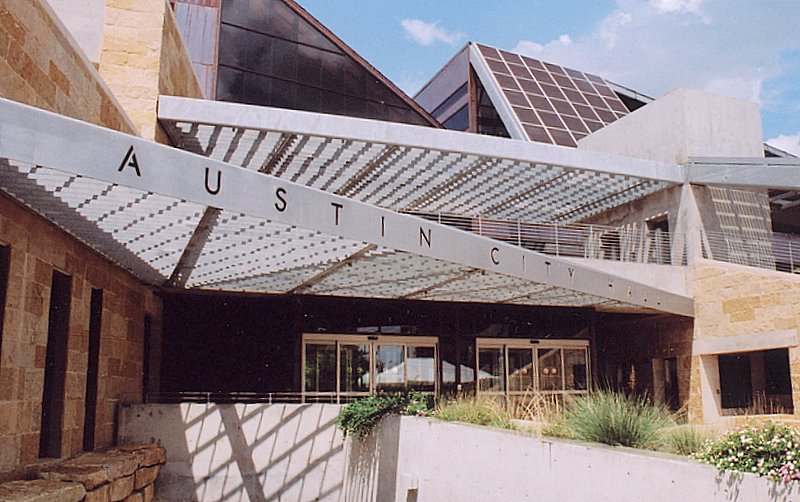 Want to vote in the upcoming City of Austin Municipal Elections? The deadline to vote in the May 9th elections is this Thursday, March 9th.
Want to vote in the upcoming City of Austin Municipal Elections? The deadline to vote in the May 9th elections is this Thursday, March 9th.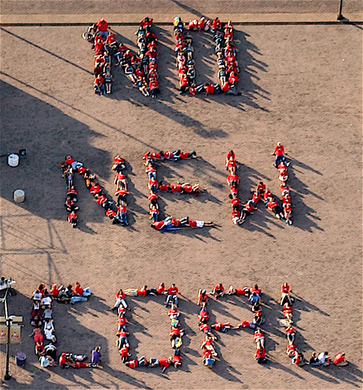 Yesterday morning we held a press conference to highlight the importance of the proposed coal moratorium bill, SB 126, sponsored by State Sen. Rodney Ellis, and its companion bill in the house, HB 4384, sponsored by Rep. Allen Vaught.
Yesterday morning we held a press conference to highlight the importance of the proposed coal moratorium bill, SB 126, sponsored by State Sen. Rodney Ellis, and its companion bill in the house, HB 4384, sponsored by Rep. Allen Vaught. I have been remiss in my duties as Blog Lady because I haven’t told you anything about the slated Andrews County nuclear waste dump. Oh, you hadn’t heard? TCEQ approved a “low-level” radioactive dump out in the lower panhandle. There wasn’t a contested case hearing — and citizens of Eunice, New Mexico, the closest town to the dump, haven’t been able to officially voice their opposition because they don’t have standing under state law. The dump is also only licensed for 15 years, after which all that toxic waste will be the responsibility of the state. Aaaaand the dump will be accepting waste, not just from Texas, but from all over the United States.
I have been remiss in my duties as Blog Lady because I haven’t told you anything about the slated Andrews County nuclear waste dump. Oh, you hadn’t heard? TCEQ approved a “low-level” radioactive dump out in the lower panhandle. There wasn’t a contested case hearing — and citizens of Eunice, New Mexico, the closest town to the dump, haven’t been able to officially voice their opposition because they don’t have standing under state law. The dump is also only licensed for 15 years, after which all that toxic waste will be the responsibility of the state. Aaaaand the dump will be accepting waste, not just from Texas, but from all over the United States.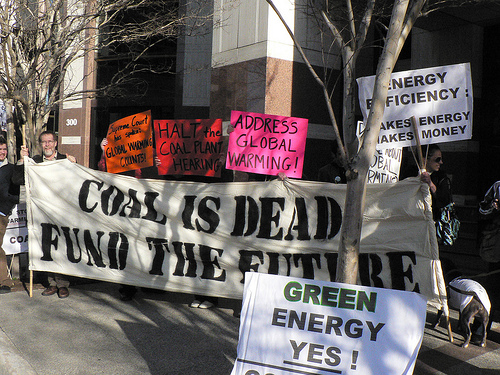 Last Friday two administrative law judges refused to hear testimony on the impact of carbon dioxide emissions during the permitting process for the NRG Limestone coal-fired power plant. The contested case hearing for NRG’s air quality permit application will be going on all week long, but testimony on the proposed plant’s contribution to global warming will not be allowed. The judges decided that the TCEQ has adopted clear policies that they would not consider testimony on the issue, even though the Supreme Court ruled in 2007 (
Last Friday two administrative law judges refused to hear testimony on the impact of carbon dioxide emissions during the permitting process for the NRG Limestone coal-fired power plant. The contested case hearing for NRG’s air quality permit application will be going on all week long, but testimony on the proposed plant’s contribution to global warming will not be allowed. The judges decided that the TCEQ has adopted clear policies that they would not consider testimony on the issue, even though the Supreme Court ruled in 2007 (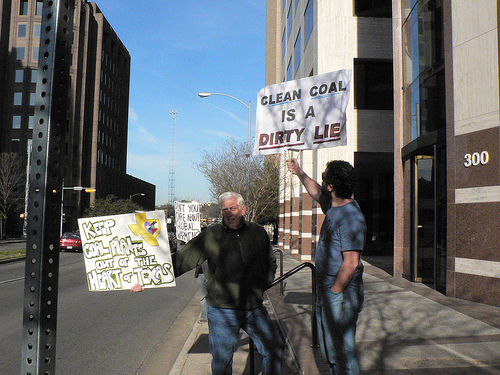 In protest, local environmentalists gathered for an 8:30 a.m. protest Monday Feb 22 outside the State Office of Administrative Hearings. Groups supporting the protest included: Public Citizen, SEED Coalition, Environment Texas, Clean Water Action, Re- Energize Texas, and the Texas Climate Emergency Campaign.
In protest, local environmentalists gathered for an 8:30 a.m. protest Monday Feb 22 outside the State Office of Administrative Hearings. Groups supporting the protest included: Public Citizen, SEED Coalition, Environment Texas, Clean Water Action, Re- Energize Texas, and the Texas Climate Emergency Campaign. Hey Look! A press release from SEED Coalition and Public Citizen:
Hey Look! A press release from SEED Coalition and Public Citizen: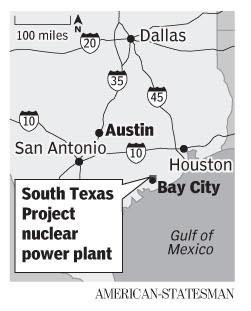 Austin should continue to steer clear of more nuclear power. Morally, it is simply wrong to leave radioactive waste to thousands of generations to come. We should instead invest in safe energy efficiency and solar and wind power, which don’t come with radioactive terrorism risks.
Austin should continue to steer clear of more nuclear power. Morally, it is simply wrong to leave radioactive waste to thousands of generations to come. We should instead invest in safe energy efficiency and solar and wind power, which don’t come with radioactive terrorism risks.

